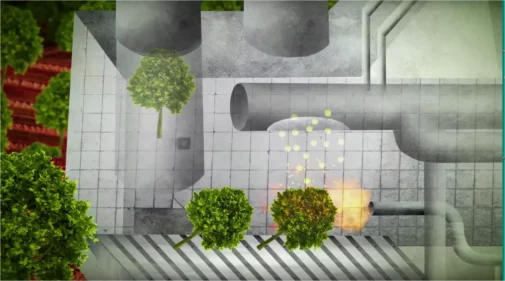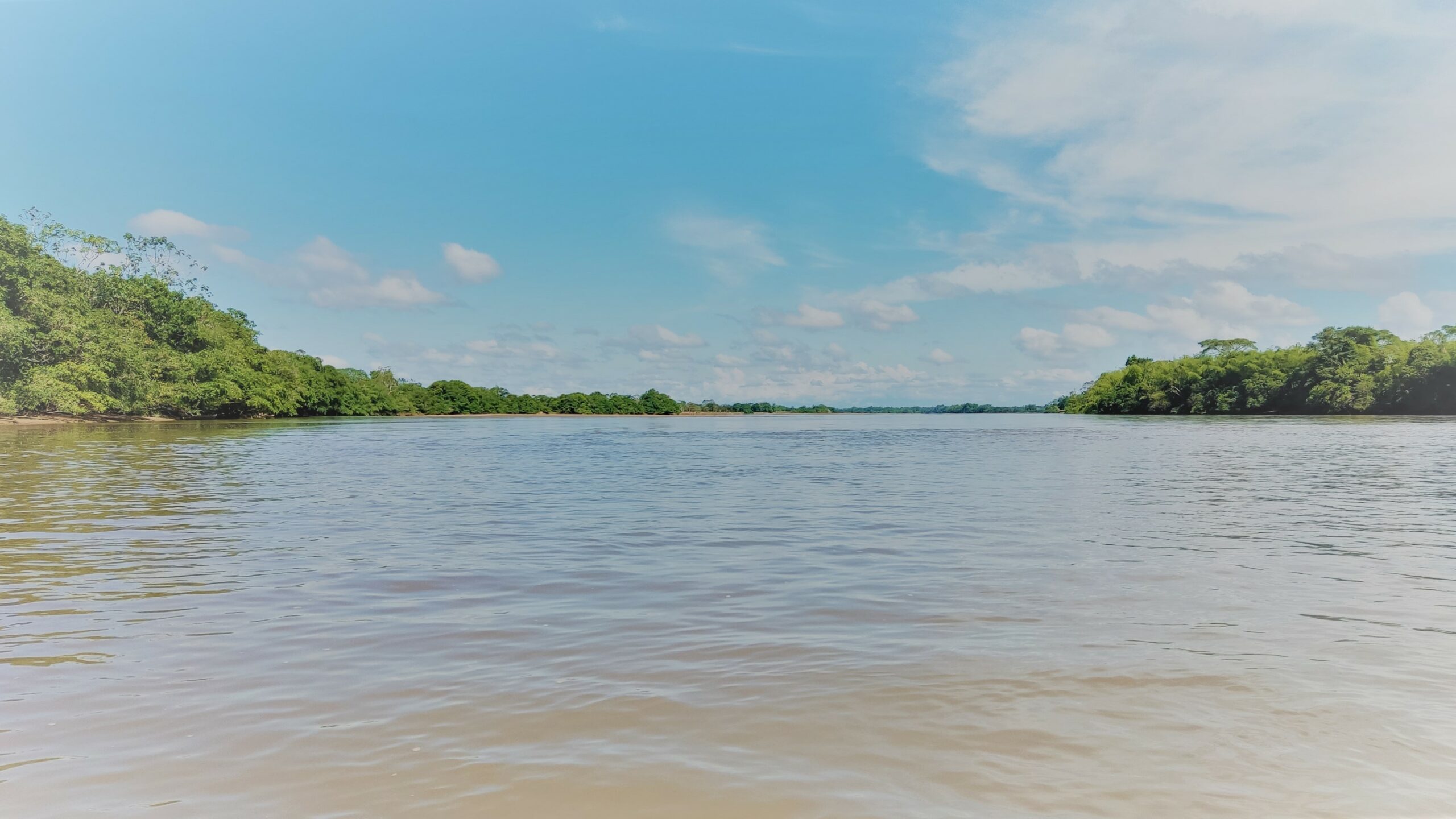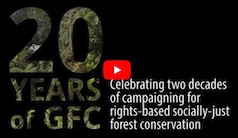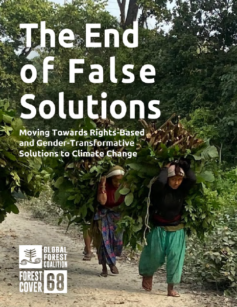Delay, Distract and Deceive: BECCS Developments in South America, Africa and Asia
Analysis: Bioenergy Carbon Capture and Storage (BECCS) technologies are among the most problematic in carbon removal geoengineering. This two-part series analyses the status of BECCS in South America, Africa, and Asia and shows that BECCS is far from being the silver bullet to climate change that some actors portray it to be.
Coraina de la Plaza, Kwami Kpondzo and Souparna Lahiri

picture: ETC Group, Biofuelwatch und Heinrich-Böll-Stiftung
licence: CC-BY-NC-ND 4.0
Geoengineering is being increasingly promoted as a “necessary” and “viable” solution to the climate crisis. Overall, there is concern not only about the lack of research regarding the potential impacts of these emerging technologies, but also about the lack of international governance frameworks and regulations to control their testing and deployment. These technologies are mainly supported by countries like the USA, Saudi Arabia, UK, Japan and the EU. At the policy-making multilateral level, while there are United Nations (UN) bodies like the Convention on Biological Diversity (CBD) that have a moratorium on geoengineering, others like the United Nations Framework Convention on Climate Change (UNFCCC) are not only more welcoming of it, but are even facilitating working streams where geoengineering approaches can proliferate, such as Article 6.4 of the Paris Agreement and the oceans and climate change dialogues.
Carbon Dioxide Removal (CDR) is one of the main proposals of geoengineering, and encompasses a wide array of approaches that claim to remove CO2 from the atmosphere, including Bioenergy Carbon Capture and Storage (BECCS). BECCS technologies consist of burning very large quantities of cultivated crops, trees, or plant residues from farmlands and forests to generate electricity, and then capturing and storing the carbon dioxide emissions arising from the combustion process underground. The CO2 is then transported and stored underground, theoretically, for long-term storage using extremely energy-intensive and often water-intensive processes or/and machines to capture the CO2 in large-scale underground pipeline networks.
We have analyzed the status of BECCS in South America, Africa, and Asia, and as this two-part series of articles show, BECCS is far from being the silver bullet to climate change that some actors portray it to be, as we simply do not have enough land to take BECCS to scale and if roll-out, it would have significant negative impacts on land, communities, the climate, and the environment.
Part One: South America and Africa
Brazil: the cradle of land-based geoengineering in South America
Land-based geoengineering, and in particular BECCS, is still a relatively new technology in Latin America. According to various sources and actors that promote BECCS such as the International Renewable Energy Agency (IRENA) and the Global CCS Institute, BECCS has the potential to be deployed on a larger scale in the short to medium term. There are multiple feasibility studies underway in countries like Argentina, Mexico, and Brazil, with Brazil being the most likely to host the region’s first BECCS plant.
The current position of the Brazilian government on CCS, and in particular on BECCS, is not clear yet. While Brazil has expressed concerns in the past about CCS leakage risks, and its feasibility in Global South countries, it was also one of the few countries that – together with Petrobras, a major state-owned petroleum corporation – was involved in the research and development of CCS technologies. Currently, the private sector and other interested stakeholders are pushing for a regulatory framework to make CCS projects commercially interesting and available. The senate has approved a bill to regulate the carbon market, which now awaits congressional and Presidential approval.
There are currently three CCS projects in Brazil: i) CCUS-EOR, Petrobras, in the Tupi, Mero and Búzios offshore fields, which aim to inject. 80 million tons of CO2 by 2025; ii) capture of CO2 (using zeolites) from coal-fired thermoelectric power generation in Criciúma, which is in the pilot phase and iii) BECCS, FS Bioenergia. We will focus on the latter in this article, but it is important to note that agriculture has not been included so far in the aforementioned draft bill on CCS, and thus, it is not clear how the bill could affect and be applied to this project.
Fueling Sustainability (FS) is a Brazilian biorefinery that prides itself in using corn in 100% of its production, and is the fourth largest producer of biofuel in the country. FS is a joint venture between the Summit Ag Group and Tapajós Participações S.A. The former controls corn-based ethanol plants in the U.S., and the latter is owned by Brazilian businessmen and operates as holding companies and non-financial institutions. FS is located in Lucas do Rio Verde, Mato Grosso.
FS has several businesses, including ethanol production, animal nutrition, corn and corn oil, biomass for energy production, and a considerable carbon agenda. The carbon agenda includes the use of biomass to source energy, mainly from “planted eucalyptus forests”, but also from other types of materials, such as bamboo, cotton ratoons, açaí seeds, and sawmill residues. According to various sources, there will be a shortage of biomass for power generation in the coming years, and to overcome this and continue operations, FS plans to establish partnerships with eucalyptus and bamboo producers, and convert 40,000 hectares of degraded lands in the State of Mato Grosso into renewable biomass plantations. However, it is unclear what FS means by “degraded lands.”
One of FS’ 2030 Agenda targets is to achieve negative carbon emissions for ethanol through the implementation of a BECCS plant at the Lucas do Rio Verde unit, which will be opened in 2024. The estimated investment for the implementation of the technology is BRL 342 million and the project is now entering phase 3, which means they are drilling and exploring where the carbon will be injected. FS also aims to continue selling carbon credits from the expected sequestration and goes as far as stating that “Lucas do Rio Verde may be a pioneer in RenovaBio , with a negative carbon footprint through BECCS” . In 2022, through Renovabio, FS sold 441,000 CBIO credits (Decarbonization Credits) and aims to reach 32 million CBIOs by 2030. However, carbon markets are yet another false solution that does not address the root causes of the problem they are trying to address, in this case also the climate crisis, and that has proven during the last decades to be a failure. This makes this project all the worse.
Corn is the main agricultural product in Brazil after soybean. However, it is now heavily used to produce biofuels and animal feedstock instead of food for human consumption. In fact, the Brazilian market for corn-based ethanol, most of it located in Mato Grosso, has grown 800% during the last five years, and exports have largely increased during this period. A study published this year links FS’ executives to illegal deforestation in Mato Grosso and areas surrounding the plants. The research also links the expansion of corn and eucalyptus plantations to this illegal deforestation.
FS is part of the portfolio of AndGreen, a Foundation established in the Netherlands in 2017 that acts as a financial intermediary giving grants and loans to projects and companies like Marfrig, one of the largest meat and food processing companies in Brazil and globally. Marfrig has repeatedly been linked to deforestation and human rights violations. AndGreen committed a USD 30 million loan for a term of 8 years last year. It also states that “additional investments of over USD 100 million to fund future expansion activities are expected from a combination of banks and bilateral and multilateral investors”.
Coincidentally, in July 2023, AndGreen submitted a project for approval of the Green Climate Fund (GCF). During the GCF board meeting in July 2023, funding proposal 212, ‘Investing in Inclusive Agriculture and Protecting Forests’, was approved and will provide USD 185 million loan and USD 9.35 million grant. In the funding proposal, FS Agriculture is mentioned as part of the AndGreen portfolio. However, it is not clear what amount of funds from the GCF could actually reach FS’ BECCS facility. This could constitute one of the first cases of multilateral climate finance going to a BECCS project.
Africa: caught in the loop of geoengineering financiers
According to Geoengineering Monitor, there have been several ongoing attempts to develop geoengineering projects in Africa. These include a project in Tanzania that aimed to promote large-scale marine permaculture by creating artificial upwelling in Tanzanian marine waters, and a project in Morocco that aimed to fertilise the ocean. In South Africa, the ocean European Iron Fertilisation Experiment (EIFEX) was conducted and currently, ClimateWorks and Great Carbon Valley are exploring the development of a Direct Air Capture project in Kenya. There is no updated information available about most of these projects, and some of them, such as the project in Tanzania, were cancelled owing to financial reasons..
Despite the potential risks of geoengineering, it continues to be pushed in Africa, including research into Solar Radiation Management (SRM). The African Ministerial Conference on the Environment (AMCEN) is involved in Solar Radiation Management (SRM) discussions. Workshops were held in Africa in 2012 and early 2013 on the governance of research into SRM, and their resulting reports concluded that there is not enough information available about SRM to conclude whether it is helpful or harmful for managing climate risks, and that more research is needed to understand its full implications.
In August 2023, AMCEN also called for a global non-use mechanism for SRM, and cautioned against the promotion of Carbon Dioxide Removal (CDR) approaches until the risks are better understood.
Studies show that the implementation of IAMs would deploy large amounts of BECCS in sub-Saharan Africa, as the region has large areas that could contribute biomass energy and storage capacities. There have also been suggestions made that the USA could meet its ambitious national emissions targets in 2050 by buying offsets from African BECCS projects. However, as noted earlier in this article, this would be an expensive experiment with far reaching consequences for forests, biodiversity, human rights, and the right to food and livelihood.
Part Two: BECCS in Asia: worsening forest loss and the climate crisis
Japan’s government is an early and strong supporter of CCS, and CCS technologies are considered key to achieving Japan’s carbon neutrality goal by 2050. The country’s industry ministry is working to create a legal framework for CCS, and released a long-term road map earlier in 2023 that targets commercial deployment and aims for the storage of 6-12 MtCO2/yr by 2030, and 120-240 MtCO2/yr by 2050.
Japan is also a key actor in pushing for the establishment of a common international legislative framework for CCS projects and creating rules to govern them at the regional level. This is particularly important for Japan since there is a scheme in the regulatory framework that allows Japan to transport CO2 and store it in other countries whenever it is not possible to store it in Japan itself. Thus, it is not surprising that Japan already has a few CCS operations facilities, including a BECCS project.
Japan has been a significant importer of Palm Kernel Shells (PKS), a byproduct of palm oil crushing, ever since palm oil by-product became authorised as biomass for the Feed in Tariff (FIT) system in 2012. Estimates point to imports of 2.5 million MT of PKS and other palm residues in 2019, used as feedstock by medium and large (over 20 MW) FIT-eligible biomass power plants. This figure is expected to reach 5 million MT by 2025, due to an increasing number of biomass power plants requiring reliable and cheap feedstock. As of April 2022, palm oil and its derivatives used in biomass power plants in Japan were not required to be certified by the Roundtable on Sustainable Palm Oil (RSPO).
The Japanese market includes a mix of certified, and non-certified, and illegally sourced commodities, referred to as a ‘leakage market’. The Japanese government incentivizes the use of “renewable energy” and has spurred the use of palm oil, palm kernel shells, and wood pellets for so-called renewable power generation.
In October 2020, Toshiba Corporation announced that “it has started the operation of a large-scale carbon capture facility” and that “the new facility to commence operation will be the world’s first Bio energy power plant to be applied with a large-scale Carbon Capture and Storage (BECCS) capability.” This is the Mikawa Plant, operated by Toshiba ESS’s subsidiary, SIGMA POWER Ariake Corporation (SPAC), in Omuta, Fukuoka Prefecture. It is funded by Japan’s Ministry of Environment (MOE) and uses PKS as its primary fuel source.
Research shows that 70% of PKS burned in power stations in Japan comes from Indonesia – the largest exporter of oil palm kernel shells used in biomass power plants in Japan.- and 30% from Malaysia.
Another biomass power plant in Mikawa using PKS sources its raw material from the provinces of Johor, Sarawak, Sabah, in Malaysia and West Kalimantan, Central Kalimantan, North Sumatra, Riau, Jambi of Indonesia.
The growing demand for PKS in Japan has resulted in a series of harrowing environmental, political, and social impacts in SouthEast Asia. For instance, palm oil development is a root cause of Indonesia’s forest and peatland fires, which reportedly led to the destruction of some 4.4 million ha of land between 2015 and 2019. Exports of palm oil linked to deforestation in Indonesia is estimated to be around 12 Mt, worth US$6 billion in 2019 alone. Forest Trends estimates that 89% of Indonesia’s forest loss was driven by commercial agriculture, almost half for oil palm plantations. A review by Indonesia’s Supreme Audit Agency concluded that 81% of oil palm concessions violated one or more laws or mandatory management standards.
The Forest Stewardship Council (FSC) has found that these plantations are also sites of human rights abuses, including violations of Indigenous rights and labour rights. Forest Trends also cites reports by NGOs like the Anti Forest Mafia Coalition on the illegalities in the commercial agriculture sectors. Indigenous Adat communities have reported violations of legal requirements for compensation and benefits sharing, and free, prior, informed consent (FPIC).
In Malaysia, 3.3 Mha of forest was lost between 2013 and 2019, which is 4% of all forest loss across the tropics. Two-thirds of this forest loss was reportedly driven by commodities like oil palm. The phenomenon is similar across Peninsular and Bornean Malaysia. A review by the Sabah Forestry Department found only two-thirds of 37 Forest Management Units, allocated to more than 1.8 Mha, could meet even the minimum standards. Four had to be terminated altogether. In 2019, Malaysia exported at least US$6.5 billion in palm oil linked to deforestation, much of it potentially illegal.
All the Forest Trends case studies found abuse of indigenous and local communities’ land rights and land conflicts.
At the 2021 UN Climate Change Conference COP26, 141 countries signed the Glasgow Declaration on Forests and Land Use which includes a list of six commitments to conserve and restore forests, strengthen incentives and policies for more sustainable commodity production that does not drive forest loss, and increase available financing for sustainable agriculture and forest management. While voluntary and non-binding, the Glasgow Commitment is the first declaration to bring heads of state together on deforestation including those from countries with tropical forests, and the largest palm oil producers, Malaysia and Indonesia. An accountability framework, which is now being considered for COP28, could strengthen the Declaration and may give it some teeth, impacting both the palm oil sector in Southeast Asia and the increasing use of PKS in biomass and BECCS plants as inexpensive feedstock.
Conclusions
Despite what its advocates say, BECCS largely remains an implausible option to address the climate crisis. The massive amounts of land required for its implementation would lead to, among other things, land-grabbing, conflict with and displacement of communities, deforestation and biodiversity loss. Even in modelled pathways where warming is limited to 1.5°C with no or limited overshoot, BECCS is anticipated to remove 30 to 780 GtCO2 cumulatively until 2100. These figures correspond to around 199 to 482 million hectares of cropland that will be needed of biomass supply for bioenergy by 2050. The upper end of the range is one and a half times the land area of India. These unrealistic amounts of BECCS prove the critical importance of swiftly and completely phasing out fossil fuels to achieve the 1.5°C target. Instead, reliance on CDR can be a risky distraction, potentially delaying necessary actions and leading to dangerous, possibly irreversible temperature overshoot of 1.5°C. As we saw in the example from Brazil, biomass feedstock for BECCS will have to rely on establishment and further expansion of monoculture tree plantations, which will compound all their negative impacts, including freshwater depletion, soil erosion and degradation, increased risks of fires and pests, emissions (that are usually not accounted for) from land clearance and disturbances, gender-differentiated impacts, and loss of food sovereignty and security since more land will be dedicated to crops for burning than food. It is important to remember that all this would be intensified by other CDR technologies.
Geoengineering is a dangerous distraction to real climate solutions. These climate geoengineering approaches are risky and could damage ecosystems, including marine life, stall plant growth, damage the ozone layer, and reduce rainfall while increasing warming in other areas. These technological fixes will not solve the problem of human-made climate change. It is only a way to distract and delay the urgently needed reduction of CO2 emissions.
A version of this article was originally published by Heinrich Böll Stiftung on November 27, 2023











